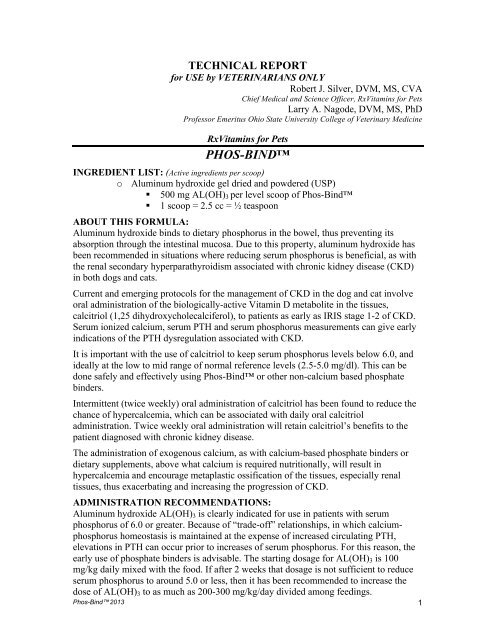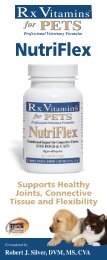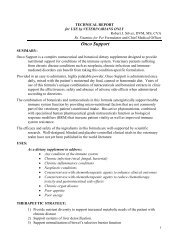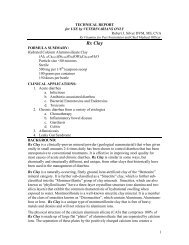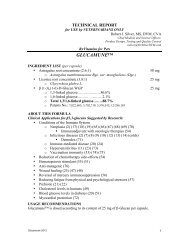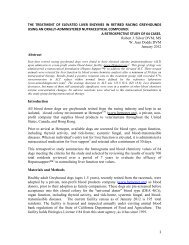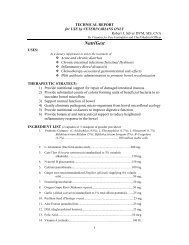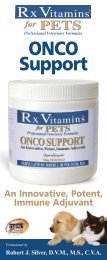PHOS-BIND™ - R X Vitamins
PHOS-BIND™ - R X Vitamins
PHOS-BIND™ - R X Vitamins
- No tags were found...
Create successful ePaper yourself
Turn your PDF publications into a flip-book with our unique Google optimized e-Paper software.
TECHNICAL REPORTfor USE by VETERINARIANS ONLYRobert J. Silver, DVM, MS, CVAChief Medical and Science Officer, Rx<strong>Vitamins</strong> for PetsLarry A. Nagode, DVM, MS, PhDProfessor Emeritus Ohio State University College of Veterinary MedicineRx<strong>Vitamins</strong> for Pets<strong>PHOS</strong>-BINDINGREDIENT LIST: (Active ingredients per scoop)o Aluminum hydroxide gel dried and powdered (USP)§ 500 mg AL(OH) 3 per level scoop of Phos-Bind§ 1 scoop = 2.5 cc = ½ teaspoonABOUT THIS FORMULA:Aluminum hydroxide binds to dietary phosphorus in the bowel, thus preventing itsabsorption through the intestinal mucosa. Due to this property, aluminum hydroxide hasbeen recommended in situations where reducing serum phosphorus is beneficial, as withthe renal secondary hyperparathyroidism associated with chronic kidney disease (CKD)in both dogs and cats.Current and emerging protocols for the management of CKD in the dog and cat involveoral administration of the biologically-active Vitamin D metabolite in the tissues,calcitriol (1,25 dihydroxycholecalciferol), to patients as early as IRIS stage 1-2 of CKD.Serum ionized calcium, serum PTH and serum phosphorus measurements can give earlyindications of the PTH dysregulation associated with CKD.It is important with the use of calcitriol to keep serum phosphorus levels below 6.0, andideally at the low to mid range of normal reference levels (2.5-5.0 mg/dl). This can bedone safely and effectively using Phos-Bind or other non-calcium based phosphatebinders.Intermittent (twice weekly) oral administration of calcitriol has been found to reduce thechance of hypercalcemia, which can be associated with daily oral calcitrioladministration. Twice weekly oral administration will retain calcitriol’s benefits to thepatient diagnosed with chronic kidney disease.The administration of exogenous calcium, as with calcium-based phosphate binders ordietary supplements, above what calcium is required nutritionally, will result inhypercalcemia and encourage metaplastic ossification of the tissues, especially renaltissues, thus exacerbating and increasing the progression of CKD.ADMINISTRATION RECOMMENDATIONS:Aluminum hydroxide AL(OH) 3 is clearly indicated for use in patients with serumphosphorus of 6.0 or greater. Because of “trade-off” relationships, in which calciumphosphorushomeostasis is maintained at the expense of increased circulating PTH,elevations in PTH can occur prior to increases of serum phosphorus. For this reason, theearly use of phosphate binders is advisable. The starting dosage for AL(OH) 3 is 100mg/kg daily mixed with the food. If after 2 weeks that dosage is not sufficient to reduceserum phosphorus to around 5.0 or less, then it has been recommended to increase thedose of AL(OH) 3 to as much as 200-300 mg/kg/day divided among feedings.Phos-Bind 2013 1
Starting Dosage: 100 mg/kg/d AL(OH) 3 divided among feedings1 scoop Phos-Bind = 500 mg AL(OH) 3Note: Dosage can be increased safely to as much as 200-300 mg/kg/day ifneeded to maintain serum phosphorus below 6.0 mg/dlChronic Kidney Disease (CKD) in the dog and cat is associated with the development ofrenal secondary hyperparathyroidism and elevated levels of PTH. It is actually the PTHwhich orchestrates many of the pathologies associated with CKD, such as anemia anddepression. By intervening in the course of CKD with the intermittent use of oralcalcitriol (twice weekly), substantial benefits to quality of life and survival times havebeen measured and reported in the literature. PTH testing is helpful, but due to costconcerns, is not always feasible. It has been found that calcitriol can be safely initiatedwith benefits including but not restricted to lowering PTH when the phosphorus is 6.0 orlower, either early in the disease, or following lowering with intestinal phosphate binderssuch as Phos-Bind.THE MANAGEMENT OF CHRONIC KIDNEY DISEASE (Canine & Feline):1. Start Renal diet when patient is in IRIS Stage 2 (late) or a higher IRIS Stage to addressconcerns about muscle mass loss on lowered protein diets when such diets arestarted too early in the disease.2. Maintain serum phosphorus below 5.0 mg/dl using AL(OH) 3 at 100-300 mg/kg/daydivided among feedings; or consider the use of Lanthanum (Fosrenol) at 50-100 mg/kg/day. AL(OH) 3 and Fosrenol can be combined to reduce the cost ofFosrenol and any rare side-effects of the aluminum in the AL(OH) 3 , such astremoring or hypercalcemia.• Sevelamer-based binders may be best avoided as they bind calcitriol in the gutin addition to their binding of phosphorusa. Recheck serum phosphorus 10-14 days after changing dosage or medications3. Serial PTH testing isn’t essential but can be helpful in the management of CKDa. Recheck serum PTH levels 8 weeks after initial dose to evaluate effect whenappropriate4. Twice weekly dosing of calcitriol at 9-10 ng/kg PO at the same numerical houra. Wednesday evening and Sunday morning have been commonly recommendedfor this twice-weekly administration protocol, but other days of the weekare fine as long as the calcitriol is given the night of Day 1 and themorning of Day 4.i. Dose on an empty stomach between mealsb. It has been found that twice weekly dosing of calcitriol is at least as effective asdaily dosing and reduces the chance of hypercalcemiai. If ionized calcium remains high with twice weekly dosing of calcitriol,and its cause is undetermined (idiopathic), it is recommended to useconcurrently a bisphosphonate like Fosamax at 10 mg weekly (ormultiples of that dose) to reduce serum calcium.c. In cases of ionized calcium too low, it is recommended to dose calcitriol on atwice daily basis, using the starting dosage of 2.5 ng/kg/day to boostintestinal calcium absorptionPhos-Bind 2013 2
5. Check ionized calcium in 10-14 days following initiation of calcitriol therapy to checkfor hypercalcemia.IMPORTANCE OF SERUM <strong>PHOS</strong>PHORUS CONTROL IN ANIMALSIt has long been recognized that regulation of blood ionized calcium is vital to health.There are a number of hormones and regulators that maintain adequate calcium levels inthe body. Several of these hormones and regulators also have an important impact uponphosphorus levels.In the past ~10 years a specific class of hormones (phosphatonins) has been discovered.The role of these phosphatonins is primarily to keep serum phosphorus from getting toohigh. These mechanisms of action have been the subject of numerous studies. (3, 6,)The results of these studies have helped us understand that maintaining normal serumphosphorus levels and thus preventing hyperphosphatemia is critical with respect to thehealth of the body. Additionally, these studies into phosphatonin activity have shown thatintestinal phosphate binders, such as Phos-Bind, are essential for use in the uremicpatient.CALCITRIOL BENEFITS1. Down-regulates PTH gene to reduce serum parathyroid hormone (PTH)a. Blocks synthesis of PTH within the parathyroid gland by preventingtranscription of the PTH gene onto mRNA.2. Induces synthesis of the calcium receptor that is required to block the secretion of PTHas well as the calcitriol receptor (VDR) in the parathyroid gland (PTG)3. Prevents parathyroid gland hyperplasia during uremia4. Causes regression of the parathyroid gland from its hyperplastic state in the uremicpatient5. Comprehensive listing of additional benefits of calcitriol are found on Table 1 in thereview article by Galvao et al, 2013.6. The CKD patient administered calcitriol will have both a reduction in azotemia and asubstantial decline in the rate of progression of the renal lesions. These benefitsoccur by several mechanisms of action, including the lowering of PTH levels bythe calcitriol.7. Clinical studies and clinician observations confirm that CKD patients receivingcalcitriol supplementation have significantly prolonged survival times andsubstantially improved quality of life.CAUSES OF LOWERED CALCITRIOL1. In CKD the reduced number of functioning renal tubules reduces the synthesis ofendogenous calcitriol.2. High concentrations of serum phosphorus inhibit 1-hydroxylation of 25-hydroxyvitamin D. Serum phosphorus levels can be so high as to actually stop thesynthesis of calcitriol.3. Serum levels of a phosphatonin, Fibroblast Growth Factor 23, (FGF23) are increasedby serum phosphorus. FGF23 is a critical and powerful early suppressor of renalcalcitriol formation.NOTE: Aluminum hydroxide (Phos-Bind) has proven itself to be a safe, convenientand economical way to manage dietary intake of phosphorus in the CKD patient,especially when used concurrently with calcitriol.Phos-Bind 2013 3
SAFETY of CALCITRIOL• The half-life of calcitriol in the blood is 4-6 hours, which allows for the rapidcorrection of hypercalcemia within about 4-6 days should it occur.• The intestinal mucosal cells that are programmed for increased calciumabsorption by calcitriol are only the newly-formed cells from the crypts ofLieberkuhn prior to their full differentiation, and they only have a tissue life spanof about a week.• Thus lowering the amount of calcitriol administered will very rapidly result indiminished gut capacity for calcium absorption.• For these reasons, calcitriol is both the most potent (allowing the lowest dosages)and most rapidly-cleared form of vitamin D available, which contributes tocalcitriol’s high margin of safety in veterinary patients.PARATHYROID HORMONE TOXICITYPTH in excess is a uremic toxin which causes tissue damage and promotes theprogression of CKD pathology (1, 2). PTH toxicity has been shown to contributeto the following problems:• Creates depression by direct effects on the brain• Slows peripheral nerve conduction velocity• Contributes to uremic anemia through the loss of renal sites of erythropoietinformation as well as other mechanisms of action leading to uremic anemia• PTH excess in uremia also contributes to leukocyte malfunctions, including failuresof immunologic response, which helps explain the increased tendency of uremicpatients to infection• Interferes with the insulin-secreting response of the pancreatic beta cells to dietaryglucose which leads to carbohydrate intolerance in uremic patients.o One of the first changes in uremic patients where calcitriol therapy has beeninitiated is a return of appetiteo Calcitriol directly facilitates insulin secretion by the beta cells independent ofits effect on PTHPTH toxicity is caused by the following mechanisms of action:1. Increases levels of intracellular ionic calciuma. Activates enzymes which digest cell membranes, proteins and nucleic acids, aswell as disrupting mitochondrial production of ATP, thus also diminishingavailable energy to the tissues2. PTH can cause cellular damage in the face of normal serum ionized calcium levels,and thus needs to be treated even in the absence of elevated serum ionizedcalcium levels3. Renal tubular cells have high concentrations of the PTH receptor, thus the kidney isaffected early in PTH toxicitya. Calcium influx into tubular cells causes cytotoxicity by activating autolyticenzymes and interfering with mitochondrial ATP productionb. Progressively, calcium phosphate precipitates within tubular lumens whichfurther contributes to renal lesions. Increased loss of renal tissue worsensthe hyperparathyroidism, and the subsequent increased PTH furtherworsens the kidney damage, creating a destructive vicious cycleMechanisms of Injury Caused By Elevated Serum Phosphorus (8, 12)Phos-Bind 2013 4
1. Aspects Related to Stimulation of PTH Increased Secretion• Direct Stimulation of PTH Synthesis and Secretiono Due in part to phosphorus-mediated stabilization of the mRNA for PTH(7)§PTH mRNA and PTH serum level duration are shortened byincreased ionic calciumo High phosphorus suppresses arachidonic acid production by PTG cellswhich is stimulated by ionic calcium in its suppression of PTH secretion(9)• Suppression of renal calcitriol formation relieves PTG cells of the regulatoryeffects of calcitriol to block transcription of the PTH gene• Marked stimulation of parathyroid cellular hyperplasia generating many morePTH producing cells each of which has a basal (non-suppressible) level of PTHproduction.o Mediated by Transforming Growth Factor alpha (TGFα) and its receptor,which is also known as Epidermal Growth Factor Receptor (EGFR).o Facilitated by serum phosphorus suppression of “cyclin inhibitory” PTGcell nuclear proteins P21 and P27 which are induced by calcitriol to help itsuppress PTG cellular hyperplasia2. Aspects Related to the Most Immediate Cause of Death in Uremia (Cardiac Failure)• Coronary arteriolar mineralizations (vascular calcifications) are directlystimulated by high serum phosphorus which drives conversion of vascularmyoepithelial cells in the vessel wall into an osteoblastic phenotype which readilyforms boney tissue in vessel walls. (Osseous metaplasia)• Recent evidence indicates that high levels of the phosphatonin, FGF23, which isdriven by high serum phosphorus, are cardiotoxic, causing myocardial cellularhypertrophy, thus contributing to hypertrophic cardiomyopathy. (10)3. Aspects Related to Emerging Mechanisms of Toxicity of Excessive Serum PhosphorusLevels (11)• Partial blockage of renoprotective effects of the use of ACE-inhibitors in CKDtherapySAFETY of ALUMINUM-BASED <strong>PHOS</strong>PHATE BINDERS• Aluminum from AL(OH) 3 absorbed
REFERENCES1. Nagode LA. and Chew DJ. Nephrocalcinosis caused by hyperparathyroidism inprogression of renal failure: treatment with calcitriol. Semin Vet Med Surg (SmallAnim) 1992; 7(3):202–220.2. Nagode LA, Chew DJ, Podell M. Benefits of calcitriol therapy and serum phosphoruscontrol in dogs and cats with chronic renal failure. Both are essential to prevent orsuppress toxic hyperparathyroidism. Vet Clin North Am Small Anim Pract 1996;26(6):1293– 1330.3. Galvao J, Nagode LA, Schenk PA, Chew DJ. Calcitriol, calcidiol, parathyroidhormone and fibroblast growth factor-23 interactions in chronic kidney disease.JVECC 23(2) 2013, pp. 134-162. doi 10.111/vec. 120364. Plumb’s Veterinary Formulary 7 th Edition, 2011.5. Gerber B, Hassig M, Reusch CE. Serum concentrations of 1,25-dihydroxycholecalciferol and 25-hydroxycholecalciferol in clinically normal dogsand dogs with acute and chronic renal failure. Am J Vet Res 2003;64[9]:1161-6.6. Berndt T. and Kumar R. Phosphatonins and the Regulation of PhosphateHomeostasis. Ann. Rev. Physiol 2007; 69:341-3597. Silver J. and Naveh-Many T. Phosphate and the parathyroid. Kidney Int. 2009;75,898-9058. Almaden Y, Hernandez, A, Torregrosa V, et al. High Phosphate Level DirectlyStimulates Parathyroid Hormone Secretion and Synthesis by Human ParathyroidTissue in vitro. J. Am Soc. Nephrol. 1998; 9:1845-18529. Almaden Y, Canalejo A, Ballesteros E, et al. Effect of Extracellular PhosphateConcentration on Arachidonic Acid Production by Parathyroid Tissue IN VITRO. J.Am. Soc. Nephrol. 2000; 11:1712-171810. Faul C, Ansel O, Amaral BO, et al. FGF23 induces left ventricular hypertrophy. J.Clin. Invest. 2011; 121:4393-440811. Zocali C, Ruggenenti P, Perna A, et al. Phosphate may promote CKD progression andattenuate renoprotective effect of ACE inhibition. J. Am. Soc. Nephrol. 2011;22:1923-193012. Geddes, RF, Finch NC, Syme HM et al. The role of phosphorus in thepathophysiology of chronic kidney disease. JVECC 2013; 23(2)122-133Phos-Bind 2013 6


